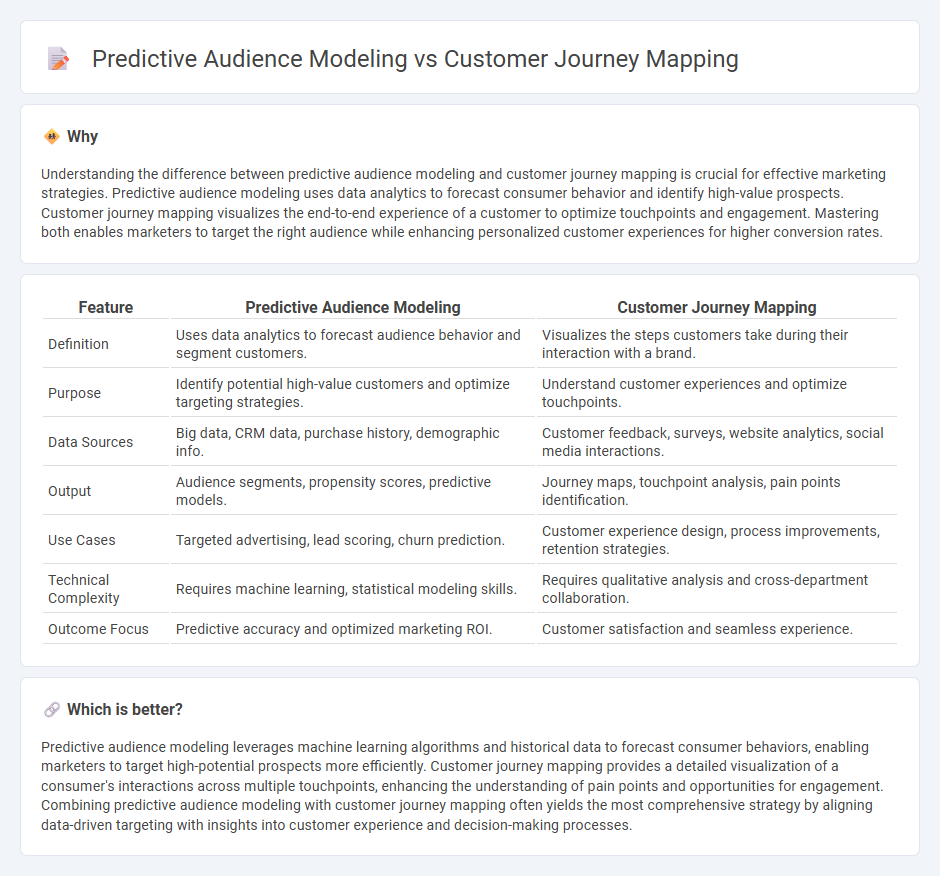
Predictive audience modeling uses data analytics and machine learning to forecast consumer behavior and target high-value prospects with personalized campaigns. Customer journey mapping visualizes the interactions and touchpoints a customer experiences, helping marketers identify pain points and optimize engagement strategies. Explore how integrating these approaches can enhance marketing effectiveness and drive growth.
Why it is important
Understanding the difference between predictive audience modeling and customer journey mapping is crucial for effective marketing strategies. Predictive audience modeling uses data analytics to forecast consumer behavior and identify high-value prospects. Customer journey mapping visualizes the end-to-end experience of a customer to optimize touchpoints and engagement. Mastering both enables marketers to target the right audience while enhancing personalized customer experiences for higher conversion rates.
Comparison Table
| Feature | Predictive Audience Modeling | Customer Journey Mapping |
|---|---|---|
| Definition | Uses data analytics to forecast audience behavior and segment customers. | Visualizes the steps customers take during their interaction with a brand. |
| Purpose | Identify potential high-value customers and optimize targeting strategies. | Understand customer experiences and optimize touchpoints. |
| Data Sources | Big data, CRM data, purchase history, demographic info. | Customer feedback, surveys, website analytics, social media interactions. |
| Output | Audience segments, propensity scores, predictive models. | Journey maps, touchpoint analysis, pain points identification. |
| Use Cases | Targeted advertising, lead scoring, churn prediction. | Customer experience design, process improvements, retention strategies. |
| Technical Complexity | Requires machine learning, statistical modeling skills. | Requires qualitative analysis and cross-department collaboration. |
| Outcome Focus | Predictive accuracy and optimized marketing ROI. | Customer satisfaction and seamless experience. |
Which is better?
Predictive audience modeling leverages machine learning algorithms and historical data to forecast consumer behaviors, enabling marketers to target high-potential prospects more efficiently. Customer journey mapping provides a detailed visualization of a consumer's interactions across multiple touchpoints, enhancing the understanding of pain points and opportunities for engagement. Combining predictive audience modeling with customer journey mapping often yields the most comprehensive strategy by aligning data-driven targeting with insights into customer experience and decision-making processes.
Connection
Predictive audience modeling leverages data analytics to identify potential customer behaviors and preferences, enabling precise segmentation. Customer journey mapping visualizes these segments' interactions across touchpoints, highlighting decision-making patterns and pain points. Integrating predictive modeling with journey mapping enhances targeted marketing strategies by anticipating customer needs and optimizing engagement paths.
Key Terms
**Customer Journey Mapping:**
Customer Journey Mapping visually represents the step-by-step experiences customers go through when interacting with a brand, highlighting touchpoints such as awareness, consideration, purchase, and post-purchase stages. This technique uncovers pain points and opportunities for personalized engagement by analyzing customer emotions and behaviors at each phase. Explore how detailed customer journey maps can optimize marketing strategies and enhance customer satisfaction.
Touchpoints
Customer journey mapping emphasizes identifying and analyzing touchpoints where customers interact with a brand, highlighting moments that shape their experiences and decisions. Predictive audience modeling leverages data at these touchpoints to forecast customer behaviors and preferences, enabling tailored marketing strategies. Discover how integrating both approaches enhances targeting precision and customer engagement.
Personas
Customer journey mapping visualizes the step-by-step experiences of Personas interacting with a brand across various touchpoints, highlighting pain points and opportunities for engagement improvement. Predictive audience modeling uses data analytics and machine learning to forecast future behaviors and preferences of Personas, enabling more precise targeting and personalized marketing strategies. Explore how integrating these approaches can enhance your audience understanding and marketing effectiveness.
Source and External Links
Customer Journey Map Guide - A detailed guide on creating a customer journey map, including setting goals, creating customer personas, identifying touchpoints, and analyzing emotions and pain points.
What is a Customer Journey Map? - IBM - Explains the concept of a customer journey map, focusing on creating personas, identifying key stages, determining touchpoints, and highlighting customer emotions and pain points.
30 Best Customer Journey Mapping Tools of 2025 - Lists a variety of tools and provides basic guidelines for creating a customer journey map, including tracking customer interactions and analyzing feedback.
 dowidth.com
dowidth.com